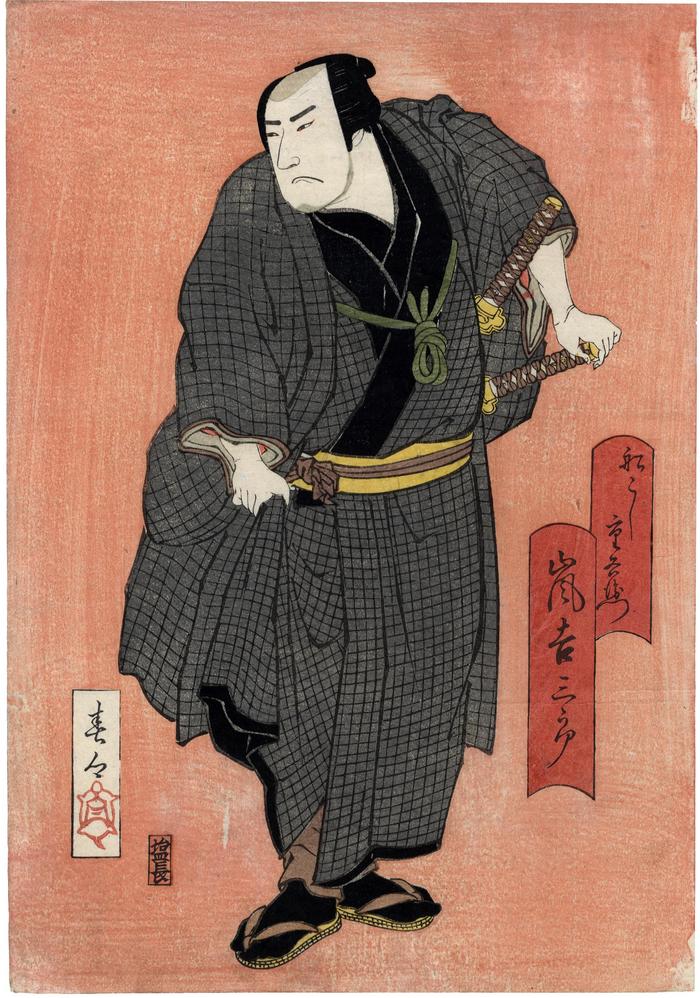Shunkyō (春郷) (artist ca 1813 – 1814)
Arashi Kichisaburō II (嵐吉三郎) as Funakoshi Jūemon (船こし重右衛門) in Yaegasumi Naniwa no hamaogi ('Eightfold Reeds Along the Seashore: Mist at Osaka')
04/1813
10.25 in x 15 in (Overall dimensions) Japanese color woodblock print
Signed: Shunkyō (春郷)
Artist's seal: Shunkyō
Publisher: Shioya Chōbei (Marks 475 - seal 25-092)
Waseda University The imposing figure of the superstar Kichisaburō II, set against a striking salmon-pink textured background.
Yaegasumi Naniwa no homaogi [sic] [八重霞浪花浜荻] ("Eightfold reeds along the seashore: Mist at Osaka") premiered as a puppet play (jōruri or bunraku) in 3/1749 at the Toyotake no shibai. It was based on a scandalous shinjū (literally "inside the heart," meaning a double suicide) that same year, a real-life event involving a prostitute named Osono and her lover, the daiku (carpenter) Rokusaburō. Yaegasumi inspired later productions, including plays introduced well into the nineteenth century, such as Sanesō nishiki bunshō featuring a nearly all-dance interpretation in Tokiwazu style. Tokiwazu had its own connection with shinjū, as it was introduced in 1739 as an alternative to a dance style called bungo bushi that was banned after authorities had judged it to be injurious to public morals for its close association with shinjū-mono (domestic dramas portraying double suicides).
Arashi Kichisaburō II (Rikan I; 1769-1821) — the founder of the Arashi line of actors — was a leading tachiyaku ("standing actor," an interpreter of male roles) from 1805 until his death. Blessed with a fine voice, a graceful manner, and good looks, he was known as Dai-Rikan ("The Great Rikan"), a stage idol celebrated for individualistic acting style, versatility, and wide range of roles, although he did not perform as an onnagata ("woman's manner," a male actor playing women's roles) or jitsu aku ("out and out villain"), preferring instead to specialize in heroic characters. His influence on Kamigata acting was significant, introducing new roles in plays premiering in Osaka (he never performed in Edo). Rikan's talents extented [sic] to the writing of poetry (haiku and kyōka), with his verses appearing in nearly twenty anthologies. As the principal rival to Nakamura Utaemon III, he became embroiled in a cause célèbre that captivated the kabuki world during the 1810s.
[This information is taken directly from OsakaPrints.com.]
****
Illustrated in a small color reproduction in 'Osaka kabuki at the BM. Quantum jumps in the print field' by Peter Ujlaki in Andon 82, July 2007, fig. 12, p. 66. " A student of Hokushū, Shunkyo's work seems to have been entirely devoted to images of Rikan, all in the ōban format which came into vogue in Osaka in l8l3, almost certainly due to rivalry-inspired market demand."
Shioya Chōbei (塩屋長兵衛) (publisher)
Kyōto-Osaka prints (kamigata-e - 上方絵) (genre)
actor prints (yakusha-e - 役者絵) (genre)
Arashi Kichisaburō II 二代目嵐吉三郎 (actor)
Kabuki (歌舞伎) theater terms (genre)
